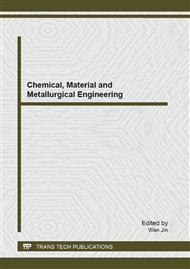[1]
Fengzhen Chen, T.R.C. Fernandes, Maria Yetano Roche, et al. Investigation of challenges to the utilization of fuel cell buses in the EU vs transition economies[J]. Renewable and Sustainable Energy reviews, 2007, 11 (2): 357-364.
DOI: 10.1016/j.rser.2005.01.007
Google Scholar
[2]
Wang L, Husar A, Zhou T, et al. A parametric study of PEM fuel cell performances[J]. International Journal of Hydrogen Energy, 2003, 28: 1263-1272.
DOI: 10.1016/s0360-3199(02)00284-7
Google Scholar
[3]
Shao, Y Y. Proton exchange membrane fuel cell from low temperature to high temperature: Material challenges[J]. Journal of Power Sources. 2007, 167: 235-242.
DOI: 10.1016/j.jpowsour.2007.02.065
Google Scholar
[4]
Saswata Bose, Tapas Kuila, Thi Xuan Hien Nguyen, et al. Polymer membranes for high temperature proton exchange membrane fuel cell: Recent advances and challenges[J]. Progress in Polymer Science, 2011, 36(6): 813-843.
DOI: 10.1016/j.progpolymsci.2011.01.003
Google Scholar
[5]
Chen-Yu Chen, Wei-Hsiang Lai. Effects of temperature and humidity on the cell performance and resistance of aphosphoric acid doped polybenzimidazole fuel cell[J]. Journal of Power Sources, 2010, 195: 7152–7159.
DOI: 10.1016/j.jpowsour.2010.05.057
Google Scholar
[6]
Gang Liu, Huamin Zhang, Jingwei Hu, et al. Studies of performance degradation of a high temperature PEMFC based on H3PO4-doped PBI[J]. Journal of Power Sources, 2006, 162: 547-552.
DOI: 10.1016/j.jpowsour.2006.07.008
Google Scholar
[7]
Samuele Galbiati, Andrea Baricci, Andrea Casalegno, et al. Experimental study of water transport in a polybenzimidazole-based high temperature PEMFC[J]. International Journal of Hydrogen Energy, 2012, 37(3): 2462-2469.
DOI: 10.1016/j.ijhydene.2011.09.159
Google Scholar
[8]
Jingwei Hu, Huamin Zhang, Yunfeng Zhai, et al. 500 h Continuous aging life test on PBI/H3PO4 high-temperature PEMFC[J]. International Journal of Hydrogen Energy, 2006, 31(13): 1855-1862.
DOI: 10.1016/j.ijhydene.2006.05.001
Google Scholar
[9]
A. Su, Y. M. Ferng, J. Hou, et al. Experimental and numerical investigations of the effects of PBI loading and operating temperature on a high-temperature PEMFC[J]. International Journal of Hydrogen Energy, 2012, 37(9): 7710-7718.
DOI: 10.1016/j.ijhydene.2012.02.004
Google Scholar
[10]
Jens Oluf Jensen, Qingfeng Li, Chao Pan, et al. High temperature PEMFC and the possible utilization of the excess heat for fuel processing[J]. International Journal of Hydrogen Energy, 2007, 32: 1567-1571.
DOI: 10.1016/j.ijhydene.2006.10.034
Google Scholar
[11]
Yanghua Tang, Jianlu Zhang, et al. Single PEMFC Design and Validation for High-Temperatrue MEA Testing and Diagnosis up to 300°C[J]. Electrochemical and Solid-State Letters, 2007, 10(9): B142-B143.
DOI: 10.1149/1.2750440
Google Scholar
[12]
Andreasen, S. J. Dynamic model of the high temperature proton exchange membrane fuel cell stack temperature[J]. Journal of Fuel Cell Science and Technology. 2009, 041006 (8 pp. ).
DOI: 10.1115/1.3081461
Google Scholar
[13]
H. I. Lee, C. H. Lee, T. Y. Oh, et al. Development of 1 kW calss polymer electrolyte membrane fuel cell power generation system [J]. Journal of Power Sources, 2002, 107: 110-119.
DOI: 10.1016/s0378-7753(01)00989-2
Google Scholar
[14]
J. Scholta, M. Messerschmidt, L. Jorissen, et al. Externally cooled high temperature polymer electrolyte membrane fuel cell stack [J]. Journal of Power Sources, 2009, 190: 83-85.
DOI: 10.1016/j.jpowsour.2008.10.124
Google Scholar
[15]
Joon-Ho Koh, Andrew T. Hsu, Hasan U. Akay, et al. Analysis of overall heat balance in self-heated proton-exchange-membrane fuel cells for temperature predictions [J]. Journal of Power Sources, 2005, 144: 122-128.
DOI: 10.1016/j.jpowsour.2004.12.055
Google Scholar
[16]
Young-Jun Sohn, Gu-Gon Park, Tae-Hyun Yang, et al. Operating characteristics of an air-cooling PEMFC for portable applications [J]. Journal of Power Sources, 2005, 145: 604-609.
DOI: 10.1016/j.jpowsour.2005.02.062
Google Scholar


